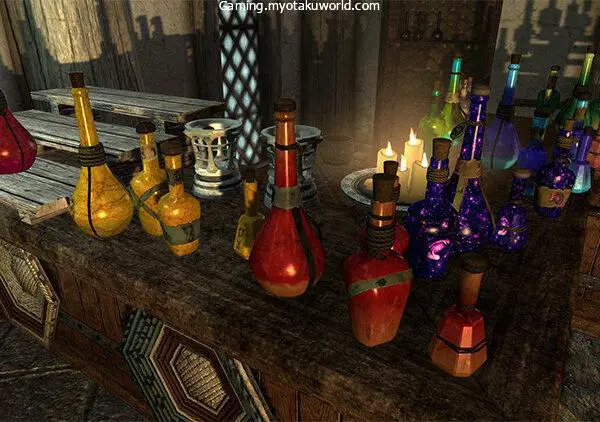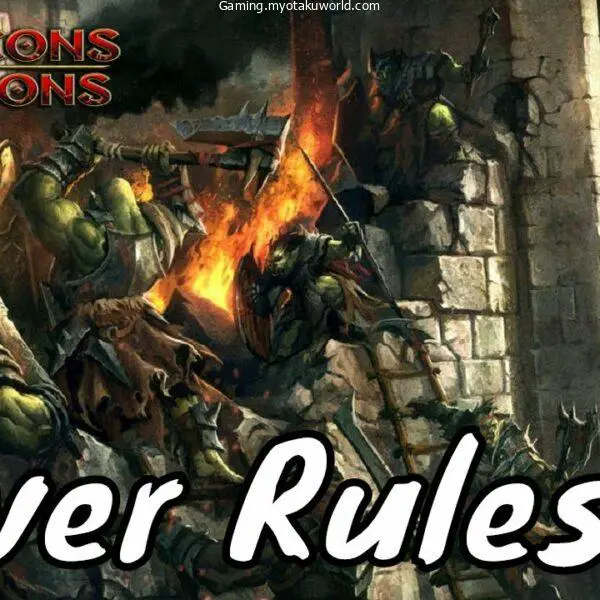By Using dimension door spell 5e in d&d You Teleport yourself from your current Location to any other spot within range. You arrive at precisely the spot desired.
It can be a place you can see, imagine, or describe by giving a distance and direction, such as 200 feet straight down or 300 feet up and 45 degrees to the northwest.
You can bring things with you if they don’t weigh more than you can carry. You can also bring one willing creature your size or smaller who is carrying gear up to its carrying capacity. When you cast this spell, the creature must be no more than 5 feet away from you.
If you would go somewhere that was already occupied by an object or a creature, you and any other creatures with you take 4d6 force damage, and the spell doesn’t work.
Dimension Door Spell Details
Type: 4th Level Conjuration
Casting Time: One Action
Range: 500 ft.
Components: V
Duration: Instantaneous
Classes: Bard, Sorcerer, Warlock, Wizard
You teleport yourself from your current location to any other spot within range. You arrive at exactly the spot desired.
It can be a place you can see, one you can visualize, or one you can describe by stating distance and direction, such as “200 feet straight downward” or “upward to the northwest at a 45-degree angle, 300 feet.”
You can bring along objects as long as their weight doesn’t exceed what you can carry. You can also bring one willing creature of your size or smaller who is carrying gear up to its carrying capacity. The creature must be within 5 feet of you when you cast this spell.
If you would arrive in a place already occupied by an object or a creature, you and any creature traveling with you each take 4d6 force damage, and the spell fails to teleport you.
Who Can Gets Dimension Door Spell?
In a way, anyone can learn this… if they have enough money to buy a rare magic item.
The bard, sorcerer, warlock, and wizard all have the dimension door spell on their lists of spells.
Trickery Domain clerics and Oath of Vengeance paladins get this spell as a bonus from their subclass, and it is always ready for them. It is also a subclass spell for Fey Wanderer rangers.
Because the spell is on the wizard spell list, Eldritch Knight fighters and Arcane Trickster rogues can also use it, even though they don’t get 4th-level spells until late in their careers.
When a human from Eberron gets the Dragonmark of Passage, dimension door and a few other spells are added to the list of spells for their class (if they have one).
Dimension door can also be cast without a spell slot from a Cape of the Mountebank. This is in addition to the people who can cast the spell with their own spell slots.
These capes are popular magic items because the one-per-day free dimension door lets any character quickly get out of a bad situation, get around an obstacle that would be hard to get around otherwise, or quickly catch up to a target when chasing them.
Bookmark, a rare and unique dagger from the Tomb of Annihilation, and the Infiltrator’s Key can also be used to cast this spell (a legendary item from Wildemount). Both are much less likely to be around in a campaign.
Pros and Cons of Dimension Door Spell
In D&D, there are several teleportation spells, and each one works a little differently.
Dimension door is one of a kind because it is a mid-level teleportation spell that lets you bring someone with you. Misty step, far step, and thunder step all have smaller ranges and different effects.
The person who casts “Scatter” can teleport up to five creatures to a short- to mid-range location.
The teleportation circle, word of recall, and teleport spells, on the other hand, can move more than one creature over a much longer distance, but they require higher-level spell slots.
So, it’s important to think about what each teleportation spell has that makes it different from the others.
Range
Dimension door is the most powerful of the lower-level teleportation spells. The person who casts it can move up to 500 feet away.
This could turn out to be very helpful. When you need to get away from a particularly nasty monster or a dangerous place, dimension door is a great tool.
Most of the time, 500 feet is more than enough to give you enough time to get away from anyone who is after you.
Only when you’re up against fast-moving creatures will it not just let you run away (like rocs, or creatures on the back of a phantom steed). 500 feet may still give you a chance to hide in places with a lot of cover.
But spells like “find creature” and “find object” only work up to 1,000 feet away. If you or something you are carrying is being followed by someone who can cast either of those spells, the 500-foot range of dimension door won’t be enough to get you out of their range.
It might still buy you enough time to get away, if you’re lucky.
Target Location
With scatter, far step, misty step, and thunder step, you have to be able to see where you want to go. With dimension door, you don’t have to.
Teleportation circle and word of recall, on the other hand, require you to teleport to a specific place, while teleport can be very dangerous if you try to teleport to a place you don’t know well.
Because of this, dimension door is one of the few spells that lets you choose where you’d rather be.
This can help if you need to find your way to a place you’ve never been before. Dimension door can be used to sneak into castles, get into some monsters’ lairs, or teleport into bank vaults (if the local mages aren’t skilled enough to stop teleportation).
Even though there are spells that stop teleportation magic, they aren’t likely to cover large fortresses completely, and most monsters don’t know how to cast spells well enough to protect their hoards or lairs.
Also, since scatter, far step, misty step, and thunder step all require that you teleport to a place you can see, they can sometimes be stopped by making the caster blind.
Those spells can be stopped by anything from darkness, blindness/deafness, or fog cloud spells to just turning off all the lights or putting a bag over the caster’s head.
This method doesn’t work on the dimension door, though, so you still have one more way to teleport to safety if you’re in trouble.
Tips and Tricks
Depending on how you use the spell, “dimension door” can be used in different ways.
And if you need ideas for how to use 5e, we have you covered:
Willing
The spell says that you can bring one willing creature that is the same size or smaller than you.
The way that works is kind of strange. Usually, an ally is willing, but what if they’ve been knocked out and you’re trying to get them to safety? Can they still be willing while they’re out?
In 5e, the words “willing” and “unwilling” don’t have clear definitions for how they work with magic. At the end of the day, it’s up to each DM to decide what to do.
Most will probably let you teleport a friend who is unconscious away from a kraken that is angry.
Another thing to remember is that a dead animal is technically an object.
If you can carry something, you can take it with you through a dimension door. This gives you another way to get the body of a fallen ally off the field if you need to get them somewhere to heal them.
This works even if the dead creature is bigger than you are, as long as you have enough strength to carry it.
Charm Spells
But one important thing about that “willing” requirement is that it doesn’t say why the target is willing.
Normally, you wouldn’t be able to grab an opponent and teleport them to a dangerous location with you.
But if you use a spell like charm person, charm monster, or suggestion to convince them to come with you, you now have a willing creature you can teleport.
It has to be a creature your size or smaller, but in the right situation, you might be able to drop suggestion on the enemy commander and then dimension door them 500 feet up in the air or over something really bad.
With any luck, your two spells might do 20d6 points of damage, or even more if the target falls into a pit of lava or an acid pool.
You’ll need a way to keep from falling in, but feather fall spells and magical items that let you fly, levitate, or teleport should help.
Environmental Hazards
Even if there isn’t a lava pit or an acid pool nearby, you can always make your own dangers.
Dungeons often have very dangerous traps, and as long as you can still use dimension door, there’s nothing stopping you from dropping a charmed enemy into one of them.
I can think of spiked pits, spinning blades, and tanks full of piranhas, but almost any kind of danger could be useful.
There are some traps that will almost certainly kill you, and if you can set up this dimension door trick, it could be very helpful.
But what if there isn’t a nearby dungeon with purple worm poison and spiked pits that can help?
You could always make your own, though. There’s nothing stopping you from setting up poison-covered spikes.
Since many enemies have good Constitution saves, it’s best to use a poison that still does half damage if they make a save.
You can also drop a temporarily friendly enemy into other dangerous situations.
In the second chapter of Xanathar’s Guide to Everything, he talks about how to use tools in the game. For these kinds of tricks, you need two of these.
Some alchemy items, like acid or alchemist’s fire, can be made with alchemist’s tools. Thieves’ tools can be used to make traps.
You don’t have to follow the rules, so you should ask your DM if you can. If it’s allowed, you can make acid vials for 12.5 gold pieces with alchemist’s supplies.
Most of the time, acid is thrown or splashed at a target as a makeshift weapon. If it hits, it does 2d6 damage.
But what if you made many acid vials? About 20 small bottles were tied together.
If your DM is in a good mood, you might be able to use thieves’ tools to turn your acid vial bundle into a trap. Your DM might also let you drop a creature right onto one of these vials.
This is definitely playing tricks on people. But if you can set it up, some DMs might be happy to let you off the hook.
If you get very lucky, the creature you drop could take 40d6 acid damage from your 20 vials.
Magical Hazards
Other, more traditional dangers include spells that make dangerous effects in certain areas.
Depending on how you time everything, you could drop a creature into an area where multiple spells do damage the first time a creature enters the area or (ideally) starts its turn there.
Spells like “Wall of Fire,” “Wall of Thorns,” “Maelstrom,” and “Evard’s Black Tentacles” all make areas of damage that are useful. Some, like Evard’s black tentacles, do damage and try to trap creatures inside the zone.
Stacking multiple spells that restrain a creature, like Evard’s or Web, means that even if the creature manages to save against one of these spells, it might fail against the other, which would mean it would still take damage from a cloudkill or other nasty spell.
Monster Bomb
This adds to the charm trick I told you about above.
The important thing to remember is that you can bring along any willing creature that is your size or smaller.
Most dangerous animals are going to be either bigger or unwilling to fight, so that’s the first problem to solve.
But let’s say, just for fun, that you knew about an enemy base. Plus, you know where to look for a dangerous animal (ideally with low Wisdom saves).
In theory, you could change the creature into a beast your size or smaller. This can be hard to do, though.
Then, you or a friend who can cast spells can use animal friendship or a similar spell to charm the animal.
You now have a creature the same size as you or smaller that is (hopefully) happy to travel with you. Maybe bring some kibble for bribes.
Then, you teleport to a spot above the camp and set the beast free. You can either have someone drop the polymorph spell or just drop the changed creature so that the damage from the fall knocks it out of its beast form.
How useful this trick is depends entirely on what you are able to change and what resources your other enemy has.
A dying dragon doesn’t pose much of a threat to a well-defended fortress with a lot of wizards there.
On the other hand, a werewolf that can’t be hurt by nonmagical attacks could cause a lot of trouble in an enemy camp that isn’t prepared for lycanthropes and doesn’t have any silvered or magical weapons.
Even though you’d have to be careful not to leave any new werewolves running around after the attack, it could still be a good way to start an assault.
Carrying Capacity
You can teleport with anything you want through a dimension door, as long as the weight is more than you can carry.
The number of pounds you can carry is 15 times your Strength score. For example, a creature with a Strength score of 18 can carry 270 pounds.
That’s nice, but we can make it bigger.
First of all, orcs, goliaths, bugbears, loxodons, and firbolgs have a trait called “Powerful Build.” Powerful Build is easy to learn and gives the creature an extra size when figuring out how much it can carry, push, pull, or lift.
Right now, we only really care about how much we can carry. For each size category above Medium, a creature can carry twice as much weight.
So, a human with 18 Strength can carry 270 pounds, but a goliath with the same amount of Strength can carry 540 pounds.
A creature with high carrying capacity and the ability to cast “Dimension Door” can be very useful. You can get more treasure out of a vault, assuming you don’t have a portable hole or another storage item.
You could also bring much bigger things into or out of battle as part of an ambush or an escape.
Now, 540 pounds is a lot, but let’s make it even more.
The enlarge/reduce spell is useful and not too hard to learn. The spell makes the target twice as big in all directions. This has a number of effects, but the most important one here is that it can carry more.
A goliath that has grown is now a Large creature that is one size bigger, so it can now carry 1,080 pounds (still assuming 18 Strength).
We can do better, again.
In Tasha’s Cauldron of Everything, there is a new fighter archetype called the Rune Knight. This type of fighter uses magic from the giants to get bigger and do other things.
Even though the class itself has a lot of cool skills, the size increase is what we care about most right now.
So, to become a big creature, our example goliath fighter uses their Giant’s Might ability. When a friendly spellcaster casts “enlarge/reduce,” our “goliath” Rune Knight is now a “Huge” creature that lifts like a “Gargantuan” creature.
We’re talking about a goliath as big as a real giant and strong enough to lift 2,160 pounds.
At level 18, our Goliath could get even bigger because their Giant’s Might feature now lets them grow to Huge size. That means that making them bigger would make them Gargantuan.
Powerful Build isn’t likely to help here because the Goliath Rune Knight can’t be any bigger than Gargantuan. The Colossal size category, which was in earlier editions, was taken out of the 5th edition.
Now we just have to think about what can be done when a Goliath player character can teleport and can lift more than 2,000 pounds.
Dimension door lets your giant ally just show up in the middle of a town and wreck everything like Godzilla did in Tokyo. As a way to scare someone, you could do a ritual to “call” a giant to your side.
Many creatures respect or fear giants, so they would be afraid of someone they thought could call one to them.
You could come up with a great plan where roaming “giants” keep attacking towns and you and your team keep “banishing” them. All you have to do is give your Rune Knight a cape of the mountebank, and when you tell them to, they will disappear in a puff of smoke.
Or, think of a Rune Knight Goliath with boots that can fly and 2,000 pounds of rocks that it can drop on the heads of a bandit camp that didn’t see it coming.
If you want to help, you could use your giant party member to move a lot of supplies across enemy lines, like food or medicine to castles that are being besieged.
You could even have a Rune Knight friend stop a dam from breaking or a ceiling from falling, only for them to teleport away when your enemy gets close. The creature gets hit by whatever the Rune Knight isn’t holding back anymore.
In the end, dimension door is a very useful utility spell that can be used in a number of ways to move quickly over fairly long distances.









